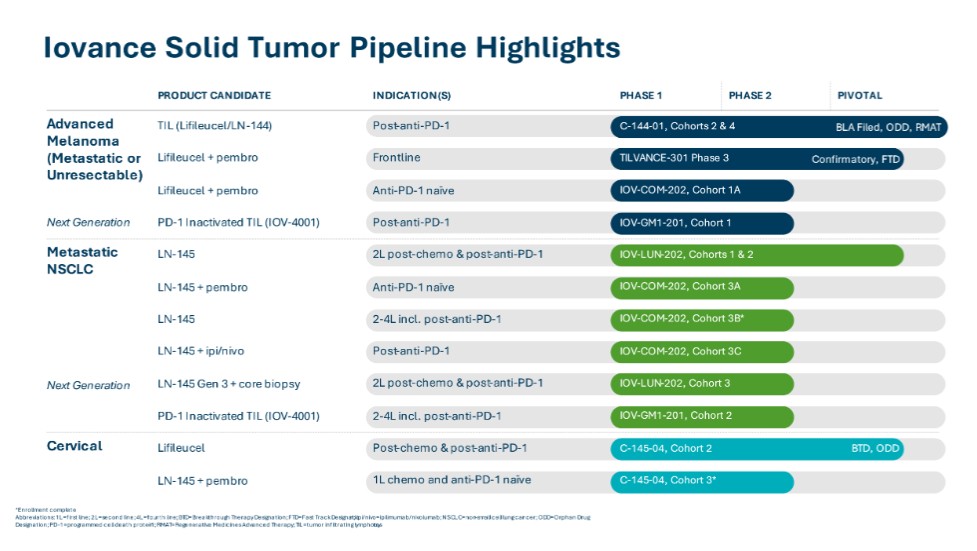| | manufacture TIL products from core biopsies as a less-invasive collection of tumor samples in a cohort of patients with NSCLC in our IOV-LUN-202 clinical trial. |
| ● | New treatment regimens: We are exploring potential avenues to improve aspects of the TIL treatment regimen. In 2020, we licensed an antibody cytokine-engrafted protein, or IL-2 analog, which we refer to as IOV-3001, from Novartis. IOV-4001 is in IND-enabling studies supporting its use as part of the TIL treatment regimen following TIL infusion. |
Intellectual Property
We have established a leading intellectual property portfolio developed internally and licensed from third parties. We currently own more than 60 U.S. patents related to TIL therapy, including patents directed to compositions and methods of treatment in a broad range of cancers, such as U.S. Patent Nos. 10,130,659; 10,166,257; 10,272,113; 10,363,273; 10,398,734; 10,420,799; 10,463,697; 10,517,894; 10,537,595; 10,639,330; 10,646,517; 10,653,723; 10,695,372; 10,894,063; 10,905,718; 10,918,666; 10,925,900; 10,933,094; 10,946,044; 10,946,045; 10,953,046; 10,953,047; 11,007,225; 11,007,226; 11,013,770; 11,026,974; 11,040,070; 11,052,115; 11,052,116; 11,058,728; 11,083,752; 11,123,371; 11,141,438 11,168,303; 11,168,304; 11,179,419; 11,202,803; 11,202,804; 11,241,456; 11,254,913; 11,266,694; 11,273,180; 11,273,181; 11,291,687; 11,304,979; 11,304,980; 11,311,578; 11,337,998; 11,344,579; 11,344,580; 11,344,581; 11,351,197; 11,351,198; 11,351,199; 11,364,266; 11,369,637; 11,384,637; 1,433,097; 11,529,372; and 11,541,077. More than 35 of these patents are related to our Gen 2 TIL manufacturing processes and have terms that we anticipate will extend to January 2038, not including any patent term extensions or adjustments that may be available. Our owned and licensed intellectual property portfolio also includes patents and patent applications relating to TIL, MIL, and PBL therapies; frozen tumor-based TIL technologies; remnant TIL and digest TIL compositions, methods and processes; methods of manufacturing TIL, MIL, and PBL therapies; the use of costimulatory and T-cell modulating molecules in TIL therapy and manufacturing; stable and transient genetically-modified TIL therapies, including genetic knockouts of immune checkpoints; cytokine-tethered TIL therapies; methods of using ICIs in combination with TIL therapies; TIL selection technologies; and methods of treating patient subpopulations.
Impact of COVID-19 on our Business
Operations and Liquidity
The full impact of the novel strain of coronavirus, or COVID-19, pandemic is unknown and continuously evolving. While the potential economic impact brought by and over the duration of the COVID-19 pandemic may be difficult to assess or predict, the COVID-19 pandemic has resulted in significant disruption of global financial markets, which could in the future negatively affect our liquidity. In addition, a recession or market volatility resulting from the COVID-19 pandemic could affect our business. We have taken proactive, aggressive action throughout the COVID-19 pandemic to protect the health and safety of our employees and expect to continue to implement these measures until we determine that the COVID-19 pandemic is adequately contained for purposes of our business. We may take further actions as government authorities require or recommend or as we determine to be in the best interests of our employees. We do not believe that the COVID-19 pandemic had a material impact on our liquidity or results of operations for the three and six months ended June 30, 2023. Further, to date, the COVID-19 pandemic has not had significant effects on our clinical trial enrollment. Given the nature and type of our short-term investments in U.S. government securities, we do not believe that the COVID-19 pandemic will have a material impact on our current investment liquidity.
Outlook
Although there is uncertainty related to the anticipated impact of the recent COVID-19 pandemic on our future results, we believe our current cash reserves leave us well positioned to manage our business in light of the COVID-19 pandemic. However, the impacts of the COVID-19 pandemic are broad-reaching and continuing and the financial impacts associated with the COVID-19 pandemic are still uncertain.
The COVID-19 pandemic is ongoing, and its dynamic nature, including uncertainties relating to the ultimate geographic spread of the virus, the severity of the disease, the duration of the pandemic, and actions that would be taken by governmental authorities to contain the pandemic or to treat its impact, makes it difficult to forecast any effects on our results for future periods.
Despite the economic uncertainty resulting from the COVID-19 pandemic, we intend to continue to focus on the development of our product candidates. We continue to monitor the rapidly evolving situation and guidance from international and domestic authorities, including federal, state and local public health authorities and may take additional actions based on their
